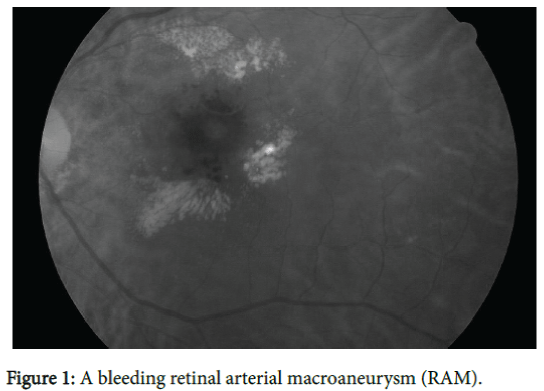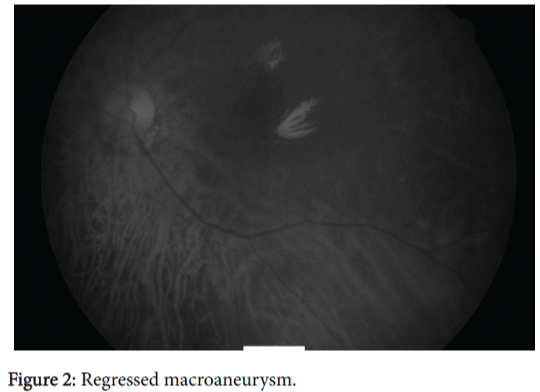Photodynamic Therapy with Verteporfin, a Novel Treatment Option for Retinal Arterial Macroaneurysm
Received: 26-Feb-2016 / Accepted Date: 13-May-2016 / Published Date: 20-May-2016 DOI: 10.4172/2476-2075.1000113
Abstract
Purpose: To report the novel use of photodynamic therapy (PDT) in a case of retinal arterial macroaneurysm (RAM).
Design: Interventional case report.
Methods: In the setting of institutional practice, a 76-year male patient presented with rapidly progressive vision loss in his left eye due to RAM. Three treatments of PDT were administered over 6 months.
Results: The patient’s macroaneurysm regressed both clinically and angiographically during and following treatment with PDT.
Discussion: Our experience, albeit limited, nonetheless suggests that PDT may be a useful adjunct to current practice in the management of RAM, and certainly warrants more formal study.
Keywords: Photodynamic therapy; Retinal arterial macroaneurysm
Introduction
First described by Robertson in 1973 [1]. RAMs are acquired, localised dilatations of an arteriole within the radius of the 3rd branch of the retinal arterial tree. Current treatment options are controversial and of unproven benefit [2]. We present the case of a 76-year old gentleman with progressive vision loss from a unilateral RAM who responded favourably to treatment with PDT using Verteporfin. To the best of our knowledge, there are no previously published reports on the use of PDT in treating RAM.
Statement of Ethics
In accordance with the declaration of Helsinki, the patient provided informed consent prior to participation. We certify that all applicable institutional and governmental regulations concerning the use of human volunteers were followed during this research.
Material and Methods
A 76-year old, Caucasian gentleman with hypertension and type 2 diabetes mellitus noticed a sudden decline in his left vision. His visual acuity was 6/5 in the right eye and 6/12 in the affected eye. Slit lamp examination was unremarkable apart from a few exudates in the left macular region. Fluorescein angiography confirmed a small leak adjacent to the fovea, surrounded by a hard exudate. The lesion’s diameter was measured at 7.696 mm2. Blood pressure, blood sugar and lipid profile all were within normal limits. Followed conservatively, within six months, his left visual acuity had deteriorated further to 6/36. A bleeding retinal arterial macroaneurysm (RAM) was noted next to his fovea (Figure 1). PDT with Verteporfin (Visudyne, Novartis Pharmaceuticals, North Ryde, NSW Australia), was performed to the left eye according to a standard protocol, which has been well described previously [3].
Results
The patient received three treatments of PDT over 6 months. Over that time interval, his BCVA improved to 6/12 and the macroaneurysm regressed both clinically (Figure 2) and angiographically. His lesion most recently measured 2.488 mm2 in diameter. No complications from PDT were noted.
Discussion
Although the natural history of RAM is one of gradual and spontaneous involution with good visual prognosis in the majority of cases, a small percentage will progress to meaningful visual loss [4], secondary to haemorrhage, retinal oedema, or exudation involving the central macula. Released toxins, outer retinal shear forces, and a diffusion barrier created by hemorrhage are believed to contribute to photoreceptor damage and visual loss [5]. In our case, treatment became warranted when central vision loss occurred. Currently employed treatments for RAM are controversial and of unproven benefit [2]. Depending on the location of the RAM, these treatments can cause additional, significant functional damage. The use of PDT with Verteporfin for RAM has not been previously reported. Previous studies have confirmed that PDT has been used effectively in treating age-related macular degeneration and several types of cancer and precancer. As the RAM involved the central macula, PDT was a safer option as it allows a selective occlusion of vascular lesions without damaging adjacent retinal structures. Although the exact mechanism of PDT is unknown, vascular-targeting PDT is believed to permeabilize blood vessels through the formation of endothelial intercellular gaps, which are postulated induced via endothelial cell microtubule depolymerization following vascular photosensitization [6]. We speculate that a similar mechanism of action might be involved in causing the regression of the bleeding from the induction of endothelial cell death resulting in the occlusion of blood vessels.
We have presented the case of an older gentleman with rapidly progressive vision loss in his left eye due to RAM, who received three treatments with PDT over six months. His lesion regressed, his vision improved dramatically and he suffered no complications from treatment. Although our evidence merely is anecdotal and involves but one patient, nonetheless we believe that our report should be a springboard to further research. Such research should not only assess the clinical value of PDT in the management of RAM, but also to provide a better understanding of the mechanisms involved.
References
- Robertson DM (1973) Macroaneurysms of the retinal arteries. Trans Am Acad Ophthalmol Otolaryngol 77: OP55-67.
- Pitkänen L, Tommila P, Kaarniranta K, Jääskeläinen JE, Kinnunen K (2014) Retinal arterial macroaneurysms.Acta Ophthalmol92:101-104.
- (1999) Photodynamic therapy of subfoveal choroidal neovascularization in age-related macular degeneration with verteporfin: one-year results of 2 randomized clinical trials--TAP report. Treatment of age-related macular degeneration with photodynamic therapy (TAP) Study Group.Arch Ophthalmol 117: 1329-1345.
- Tonotsuka T, Imai M, Saito K, Iijima H (2003) Visual prognosis for symptomatic retinal arterial macroaneurysm. Jpn J Ophthalmol 47: 498-502.
- Hochman MA, Seery CM, Zarbin MA (1997) Pathophysiology and management of subretinal hemorrhage. Surv Ophthalmol 42: 195-213.
- Chen B, Pogue BW, Luna JM, Hardman RL, Hoopes PJ, et al. (2006) Tumor vascular permeabilization by vascular-targeting photosensitization: effects, mechanism, and therapeutic implications. Clin Cancer Res12: 917-923.
Citation: Jeganathan VSE, Verma N (2016) Photodynamic Therapy with Verteporfin, a Novel Treatment Option for Retinal Arterial Macroaneurysm. Optom open access 1: 113. Doi: 10.4172/2476-2075.1000113
Copyright: © 2016 Jeganathan VSE, et al. This is an open-access article distributed under the terms of the Creative Commons Attribution License, which permits unrestricted use, distribution, and reproduction in any medium, provided the original author and source are credited.
Share This Article
Open Access Journals
Article Tools
Article Usage
- Total views: 12489
- [From(publication date): 6-2016 - Apr 19, 2024]
- Breakdown by view type
- HTML page views: 11786
- PDF downloads: 703


